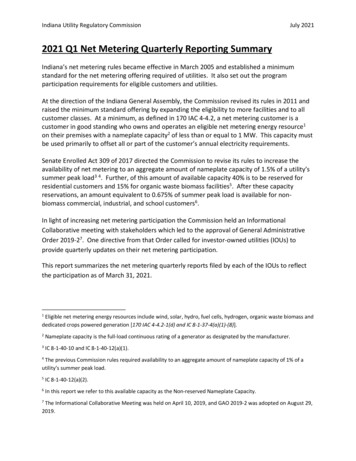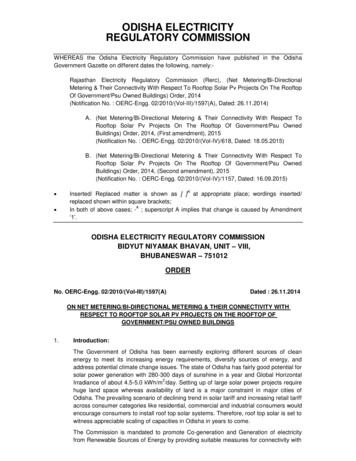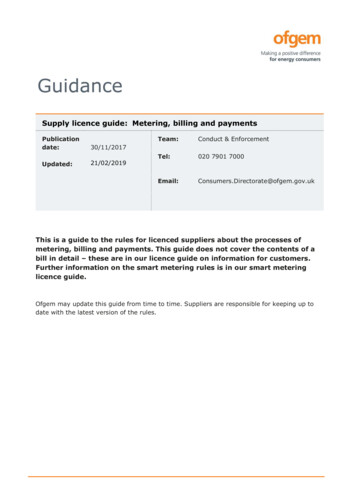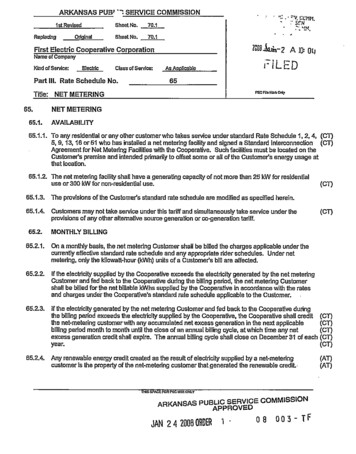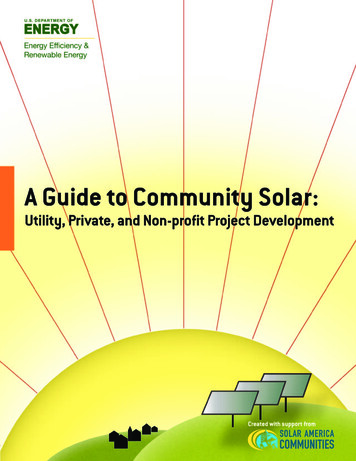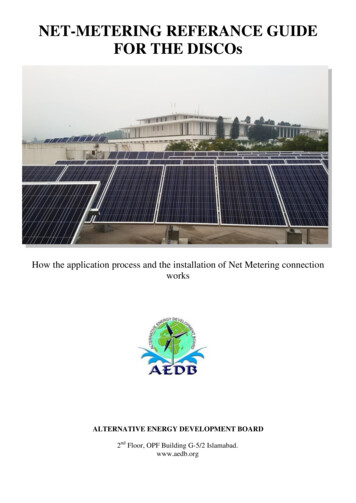
Transcription
NET-METERING REFERANCE GUIDEFOR THE DISCOsHow the application process and the installation of Net Metering connectionworksALTERNATIVE ENERGY DEVELOPMENT BOARD2nd Floor, OPF Building G-5/2 Islamabad.www.aedb.org
Table of ContentsGlossary . ii1. Introduction. 11.AAbout Net Metering . 11.BBackground . 11.CNet Metering in Pakistan . 21.DRole of Distribution Code Review Panel (DCRP) . 22. Steps involve in Net Metering . 32.AOverview and timeline of the Procedure for Net Metering Connections. 32.A.1Application for Net Metering. 32.A.2Acknowledgement of application . 32.A.3Technical feasibility in initial review . 42.A.4Agreement . 42.A.5Generation license. 42.A.6Connection Charge Estimate. 42.A.7Payment of CCE . 52.A.8Installation of interconnection facility . 53. Interconnection Requirements . 73.AInitial requirements . 73.A.1Technical feasibility requirement . 73.A.2NOC by Electrical Inspector . 73.A.3Grid Interconnection Standard: Electrical Parameters . 73.A.4Inverter standards . 93.A.5Safety and EMC Standard. 93.A.6Load flow study . 93.A.7Upgrading the Transformer. 93.BMandatory requirements . 93.B.1Interconnection disconnect switch . 93.B.2Anti-islanding . 103.B.3Single line diagram . 103.B.4Earthing Protection . 103.B.5Lightning and surge protection . 104. Operating procedure . 134.ABilling procedure . 134.BPeriodical inspection . 144.CGeneral . 145. Useful links . 155.ANational Electric Power Regulatory Authority (NEPRA) . 155.BAlternative Energy Development Board (AEDB) . 15Annexure. 17i
KRPVREULAlternative Energy Development BoardConnection Charge EstimateDistributed GeneratorDistribution CompanyEuropean StandardInternational Electro-technical CommissionInstitute of Electrical and Electronics EngineersKilowattsKilowatt hourKilowatt peakMegawattNational Electric Power Regulatory AuthorityNon-governmental organizationPakistani RupeePhotovoltaicRenewable EnergyUnderwriters Laboratoriesii
Net Metering Hand Book1.IntroductionThis guide provides an overview of important points to consider when then consumer apply forthe Net Metering as per NEPRA (Alternative and Renewable Energy) Distributed Generationand Net Metering Regulation 2015. This guide attempts to walk the DISCO office andDISCO’s personnel through the different stages beginning from the application by theconsumer up to the installation of Net Metering DG facility and the1.AAbout Net MeteringNet metering is an electricity policy for consumers who own Renewable Energy facilitieswhich allows them to use electricity whenever needed while getting credit for contributingtheir production to the grid.Producing electricity partly for own consumption, and partly for sale to the DISCO, is nowavailable in the Pakistan. Solar and Wind Energy is a long term power solution. The Solar PVTechnology gives access to affordable electricity supply during system life. Residential andcommercial customers can switch their electricity load to Solar/Wind energy and can slashtheir power bills.Figure 1.1 Net Metering processThis picture illustrates the flow of electricity from power generation via high voltagetransmission and distribution utilities to the end-user who can now install a renewableenergy facility and send t h e not needed electricity back to the distribution grid and earncredit for his export.1.BBackgroundPakistan has been facing energy crisis for the past few years as the demand and supply gap haswidened. The country’s current energy demand far exceeds its generation resources, and facingan energy shortfall of 4000 MW as a result load-shedding and power blackout have becomesevere issue.1
Net Metering Hand BookKeeping in mind above issues The Government of Pakistan promotes investment in thegeneration of small scale distributed renewable energy, through the Alternative EnergyDevelopment Board (AEDB), on the basis of net-metering concept.1.CNet Metering in PakistanThe National Electric Regulatory Authority (NEPRA) announced the official DistributedGeneration and Net Metering Regulations on September 1st, 2015. As per these regulations,any customer of the electric grid (three-phase connections) can avail the possibility of NetMetering for small-scale renewable energies installations.In Pakistan, net-metering is the first policy mechanism of the Renewable Energy Act of 2006which has been fully implemented. Section 8.4.2 of the Renewable Energy Act of 2006provides that subject to technical considerations and without discrimination and upon requestby distribution end-users, DISCOs shall enter into net-metering agreement with qualified endusers who will be installing the RE system.NEPRA (Alternative & Renewable Energy) Distributed Generation and Net MeteringRegulation 2015 is added in annexes1.DRole of Distribution Code Review Panel (DCRP)DCRP was established in October 21st 2014 for the integration RE plant to be connected withDISCOs. DCRP is a standing body to undertake the functions detailed in Distribution Code.The DISCOs are bound to follow the Distribution Code for all connections.
Net Metering Hand Book2.Steps involve in Net MeteringThis chapter covers the detailed overview of the each step involved in the Net Meteringprocedure as per NEPRA’s Regulation along with the timeline. Interconnection of consumerand DISCO and interconnection of DISCO and NEPRA covers in this section.2.AOverview and timeline of the Procedure for Net MeteringConnectionsThe Power Division, Ministry of Energy (MoE) is promoting net metering and intending toprovide the services to the customers at their door step. Therefore, MoE has desired that theinstallers of systems for net metering (DG installers) as shortlisted by AEDB will be requiredto process the application for net metering on behalf of consumers applying for net meteringconnections up to 250 kW capacity. NEPRA has improved/shortened the timeperio forprocessing net metering applications. Moreover, MoE has asked DISCOs to get applicationsapproved and connections energized within one month of receipt of application from theconsumers.The Flow of steps involve in Net Metering Process along with the timeline for net meteringconnections are as follows.2.A.1Application for Net MeteringAny applicant who meets the requirement of DG asdefined in NEPRA’s regulation, submits theirapplication along with the necessary documents to thefocal person of the DISCO. Application form isattached at the Annexure and can also be downloadedfrom NEPRA’s website.2.A.2 Acknowledgement of applicationThe DISCO will acknowledge its receipt and inform theapplicant whether the application is completed in allrespect or not. For the purpose of net meteringconnections up to 250 kW capacity, NEPRA hasrelaxed requirement of inspection from ElectricInspector.Submission ofApplicationWithin one (01)working day ofreceiving applicationIncomplete application formIn case the application found incomplete, the DISCOwill return the application the same day and will ask theapplicant to complete the application and re-submit it.The applicant will have to submit the application inWithin one (01)working days of beinginformed3
Net Metering Hand Bookcomplete form to the DISCO office.Initial reviewUpon being satisfied that the applicant is complete in allrespect, The DISCO office will perform an initialreview to determine whether applicant qualifies forinterconnection facility and required additionalrequirements, like comparison between sanctioned loadand the size of the system installed.2.A.3Technical feasibility in initial reviewAs per DISCOs, for connections up to 250 kW, notechnical feasibility study is needed. Power Division,Ministry of Energy has directed the DISCOs to carryout technical studies and approve the connections at theSub-Division level. In case the initial review revealsthat the proposed facility is not technically feasible, theDISCO will return the application and communicate thereason to the applicant.2.A.4Initial review will becompleted in three (03)working daysWithin three (03)working days after thecompletion of initialreviewAgreementIf the DISCO office is satisfied that the applicantqualifies as a DG, then the DISCO and the applicantwill enter into agreement. Agreement form (Schedule-I)is added in the annexure.Within seven (07)working days of review2.A.5 Generation licenseThe DISCO office will send the copy of the agreementbetween the applicant and the DISCO to the NEPRAalong with the application for the issuance ofGeneration license. NEPRA will issue the GenerationLicence within seven working days after receipt ofrequisite documents by DISCOs.Within seven (07)working days ofsigning of agreement2.A.6 Connection Charge EstimateAfter the agreement DISCO office will issue theConnection Charge Estimate (CCE), if any, to theapplicant for the proposed interconnection facility up tothe interconnection point including meteringinstallation.The applicant have the choice either it obtains the bi-Right after theagreement
Net Metering Hand Bookdirectional meter from DISCO or purchased it fromprivate sector manufacturers and get it certified from theconcerned DISCO as per technical requirementsnotified by NTDC.2.A.7 Payment of CCEIf applicant choose to obtain the meter from concernedDISCO and DISCO has given the notice to the applicantto make the payment of Connection Charge Estimate(CCE), the applicant will pay the same and notify theDISCO office.Within three (03) daysof its issuance2.A.8 Installation of interconnection facilityWhen the charges will be paid the DISCO office willinstall and commission the proposed interconnectionfacility after the confirmation of Generation License tothe DG by NEPRA.Within three (03) daysof payment byapplicant5
Net Metering Hand Book3.Interconnection RequirementsThis chapter will cover the requirements that are needed to be checked by the DISCO office inproposed DG facility by the consumer.3.AInitial requirementsAt the beginning of application procedure DISCO office has to make sure that these initialrequirements are to be fulfilled by the applicant.3.A.1 Technical feasibility requirementAfter receiving an application for the interconnection facility, technical feasibility report is tobe prepared by the inspection committee keeping in view the following checks:a. The capacity / load on the transformer should be within the technical limits.b. Whether the proposed interconnection would require upgrading the capacity of existingdistribution network.c. Ensure phase balancing to avoid unbalancing of the load in secondary circuit ofdistribution line.3.A.2 NOC by Electrical InspectorAs per amendments proposed by MoE to NEPRA, the requirement of NOC by ElectricInspector for net metering connections up to 250 kW is omitted. NOC by Electrical inspectorshould be provided by those applicants along with their application form that are installing netmetering connections above 250 kW.Scope of the NOC includes grounding tests, insulation tests, wiring size suitability and generalsafety of complete internal wiring.3.A.3 Grid Interconnection Standard: Electrical ParametersThe DG shall operate and inject power when the network is within the parameters mentionedhereafter. DG system shall disconnect itself from the utility network when the electricalparameter of the network falls out of the specified range.3.A.3.1Range of Operation: VoltageThe under voltage and over voltage levels and the corresponding triptimes shall be inaccordance with IEC 61727or better.VoltageV 50%50% V 85%85% V 110%110% V 135%135% VMaximum Trip Time(Seconds)0.12.0Continuous Operation2.00.057
Net Metering Hand Book3.A.3.2Range of Operation: Power FactorThe power factor must comply with requirements as per IEC 61727. The DG system shall havepower factor greater than 0.9 when the output is greater than 50% of System rating. The PowerFactor requirements set for respective consumer type by the utility company will be willremain applicable and larger DG (such as industrial connections) may be required to installadditional systems for power factor correction.3.A.3.3Range of Operation: FrequencyThe under frequency and over frequency levels and the corresponding trip times shall be asfollows:Frequency Range (Hz) 47.547.5 51.551.5 3.A.3.4Maximum Trip Time (Seconds)0.1Continuous Operation0.1HarmonicsThe inverter shall meet the Harmonic current injections in accordance with IEC 61727. Thetotal harmonic distortion shall be less than 5% at 100% rated power of the inverter. Distortionlimits for Even Harmonics and odd Harmonics are listed below:Odd Harmonics3rd through 9th11th through 15th17th through 21st23rd through 33rd33rd Distortion LimitLess than 4.0%Less than 2.0%Less than 1.5%Less than 0.6%Less than 0.3%Even Harmonics in these ranges shall be less than 25% of the odd harmonics listed. THDshould be less than 5%3.A.3.5DC Current injectionThe DC Current injection must be in accordance with IEC 61727. The PV system shall notinject DC current greater than 1% of the rated inverter output current into the utility interface.3.A.3.6Islanding ProtectionIslanding protection shall be in accordance with IEC 61727. A PV system that ceases toenergize the utility line in case of a voltage and frequency situation outside of the ranges statedin IEC 61727 within the timeframes set in the IEC 61727 is considered to be sufficientlyprotected against islanding.3.A.3.7Reconnection to the networkIn case of utility line outage, fault or out of range, the inverter shall remain disconnected and
Net Metering Hand Bookprovide Islanding Protection. The inverter shall not energize the utility line for at least 1 minuteafter the service voltage and frequency have recovered to the continuous operations rangeparameters as defined above.3.A.4 Inverter standardsAs per Regulation by NEPRA, the grid connected inverters shall comply with UL 1741standard which addresses the electrical interconnection design of various form of generatingequipment. Other standards that the DG facility should adopt to are:a. IEEE 1547 2OO3 (standard of interconnecting distributed resources with electric powersystem).b. IEC 61215 for crystalline PV modulesc. IEC 61646 for thin film PV modules3.A.5 Safety and EMC StandardFor system greater than 10kW, the inverter needs to comply with additional certifications andmeet additional Electromagnetic compatibility and Safety Standards such as:1) IEC EN 61000-62) UL17413) EN 62109-1/24) IEEE15473.A.6Load flow studyFor the Distributed Generators having an installed capacity of more than 500 kW, load flowstudy (on PSSE software) is compulsory and for the DG facility having capacity less then500K load flow study can be achieved by FDRANALoad flow study for the facility having capacity up to 250 kW is not required.3.A.7Upgrading the TransformerIn case if the load capacity due to already installed DG facilities at any transformer reaches80%, the DISCO shall not grant approval for any new DG facility at that transformer unless thenew DG Facility operator agrees and pay for the cost of augmenting the transformer capacity.3.BMandatory requirementsAccording to NEPRA Regulation, DISCO and applicant have to comply with some safetyrequirements as stated below:3.B.1 Interconnection disconnect switchDISCO personnel has to make sure that the applicant has installed an interconnectiondisconnect switch rated for its voltage and fault current requirements which will cut the flow ofenergy back to the grid if required. That disconnect switch should be locked and can beaccessible by both DG and the DISCO personnel and shall meet the applicable IEC and IEEE9
Net Metering Hand Bookstandards.3.B.2 Anti-islandingAnti-islanding is an in built feature in inverter which trips the flow of energy to the grid on gridfailure. During the connection inspection, anti-islanding feature must be tested by therespective officers of the DISCO. The inspection authority shall ensure the anti-islanding andany other protection requirement before commissioning.3.B.3 Single line diagramThe protection and control single line diagrams for the interconnection of the DistributedGenerator is to be approved by the DISCO prior to the commissioning of the system.3.B.4 Earthing ProtectionA minimum of two separate dedicated and interconnected earth electrodes must be used for theearthing of the solar PV system support structure with a total earth resistance not exceeding 5ohms as below:a. Equipment earth (DC)b. System earth (AC)Both equipment earth (DC) and system earth (AC) shall be checked for proper earthing.Equipment earth (DC): All metallic parts of DG Facility such as PV modules, DCDB, generator,iron clad Switches will be connected to earth with two separate and distinct earth connections toAvoid any loss of property or Human being.3.B.5 Lightning and surge protectionDISCO officials also have to make sure that the DG facility is separately grounded and thelightning arrestors are provided with the DG facility. The circuit breakers of rated voltage arealso installed at the facility. Surge protection shall be provided on the DC and AC sides of DGfacility.Surge Protection:i.ii.iii.iv.v.Surge protection shall be provided on the DC side and the AC side of the DGfacility.The DC surge protection devices (SPDs) shall be installed in the DC distributionbox adjacent to the solar grid inverter and generator.The AC SPDs shall be installed in the AC distribution box adjacent to the DGfacility.The SPDs earthing terminal shall be connected to earth through the abovementioned dedicated earthing system.The Lightening Arresters need to be provided for the buildings which are ofmore than 15 meters height only.
Net Metering Hand BookNOTE: The Single line diagram, Earthing and the lightning arrestors are all checkand cleared in the NOC by the Electrical Inspector mentioned in the initialrequirements.11
Net Metering Hand Book4.Operating procedureThis chapter will cover all the process involved and the requirements of the DGs and the DISCOs afterthe installation of Net Metering at DG’s premises.4.ABilling procedureAccording to NEPRA’s Regulation following procedure are to be adopted for the billing process:a. The costumer shall receive a monthly net import or net export bill indicating net import or netexport to the grid.b. The meter reader has to capture import & export energy and other billing parameters recordedby the bi-directional meter.c. In case of net import bill, the Distributed Generator shall be billed for the net kWh inaccordance with applicable tariff.d. In case, the export energy is more than the import, the net kWh shall be credited againstDistributed Generator next billing cycle.e. And on next month if the exported energy is again more than the imported energy, the net kWhshall be credited against next billing cycle unless the net energy exported is more quarterly (in3 months), the off peak net kWh shall be paid to the Distributed Generator by the DISCOf. NEPRA's regulations for net metering clearly state netting of electricity units on off-peak rates.Whether the consumer supplies units during off-peak or peak time, the units and rates theDISCOs will use for netting the units and electricity bill will be the off-peak time units andrates.g. Calculation of Sales Tax on sale of electricity is to be done on net electricity units. This isbecause that consumer and DISCOs are trading the electricity units. In accounting terms, bothare liable for Sales Tax. One way of settling Sales Tax is that both parties may settle their SalesTax at their own, which is cumbersome and much difficult for the consumers to handle. Easyway is that the net of electricity units be calculated and the party having supplied surplus unitsmay charge be liable for Sales Tax settlement. In most cases (because of solar PV/micro windsystem sizes and consumption of electricity by the consumers), it would be the DISCOs whowould have supplied more units, and therefore would have to collect Sales Tax from theconsumers, based on net electricity units. The Sales Tax would be calculated for off-peak andpeak units separately, calculations for Sales Tax of only off-peak billed units will be used fornetting off.h. Calculations of other surcharges or tariff rationalization charges etc. should be done on thebasis of total electricity units supplied by the DISCO. This is because, NEPRA regulationsallows netting of electricity units on off-peak rates only. Surcharges or tariff rationalizationcharges etc. does not fall in calculations of netting of off-peak electricity units.13
Net Metering Hand Book4.BPeriodical inspectiona. Both uni-directional and the bi-directional energy meters are to be tested once in 6 months.b. The inverter functionality of every installation is to be checked once in 6 months.c. Periodical test reports shall be made by DISCO’s personnel and submitted to the respectedofficer4.CGeneral1) The DG Facility installed by the consumer must comply with the standards and specificationsas specified by AEDB and NEPRA time to time.2) The applicant of net metering connections up to 250 kW capacity are required to install theirDG Facility through the AEDB certified installers/vendors/service providers only. Theapplicants of net metering connections above 250 kW capacity shall ensure that theinstallers/vendors/service providers shall have adequate experience, expertise and knowledgein design, supply and installation of DG Facility.3) In case the installed (also read proposed) capacity of the DG Facility is higher than thesanctioned load of the consumer, which consequently requires an up-gradation in theinfrastructure (service line meter with CT (if required), transformer upgrading (if required)),the consumer will have to upgrade at his / her / its own cost.
Net Metering Hand Book5.Useful links5.ANational Electric Power Regulatory Authority (NEPRA)Director Customer AffairAddress: NEPRA Tower Attaturk Avenue (East), Sector G-5/1,Islamabad, PakistanWebsite: www.nepra.org.pkTel: 92 51 2013200 Fax: 92 51 2600021Email: cad@nepra.org.pk5.BAlternative Energy Development Board (AEDB)Director (CDM/Solar)Address: 2nd Floor, OPF Building, Sector G-5/2,Islamabad, PakistanWebsite: www.aedb.orgTel: 92 51 9202085 Fax: 92 51 9222364Email: irfanyousuf@aedb.org15
AnnexureTO BE PUBLISHED IN THE GAZETTEOF PAKISTANEXTRAORDINARY, PART-IINational Electric Power Regulatory Authority (NEPRA)NOTIFICATIONIslamabad, the 1st day of September, 2015S.R.O 892 (1)/2015.— In exercise of the powers conferred by section 47 read with section 7(1) of the Regulation of Generation, Transmission and Distribution of Electric Power Act,1997 (XL of 1997), the National Electric Power Regulatory Authority, is pleased to make thefollowing Regulations to establish a framework for the regulation of Distributed Generationby using alternative and renewable energy and net metering, namely: 1. Short title, commencement and application. — (1)These Regulations may be called theNational Electric Power Regulatory Authority (Alternative& Renewable Energy)Distributed Generation and Net Metering Regulations, 2015.(2) They shall come into force at once.2. Definitions. - (1) In these Regulations unless there is anything repugnant in the subject orcontext,—(a)"Act" means the Regulation of Generation, Transmission and Distribution ofElectric Power Act, 1997 (XL of 1997)(b)"Agreement” means the agreement between the Distribution Company and theDistributed Generator on the Authority’s approved format as per Schedule I;(c)"Applicable Documents" means the rules and regulation issued in pursuance of theAct by the Authority, from time to time, the generation, distribution andtransmission licences, the Grid and Distribution Codes and any documents,instruments, approvals, directions or authorizations issued or granted by theAuthority in exercise of its powers under the Act and any document in each caseof a binding nature applicable to the licensee;(d)"Applicable Tariff" means tariff approved by the Authority for the relevant periodand category of consumers of the Distribution Company;(e)"Applicant” means a consumer of a Distribution Company which submits anApplication to interconnect its Distributed Generation Facility to the DistributionSystem of the Distribution Company and who applies for grant of the license tooperate a Distributed Generation Facility as a Distributed Generator;
Net Metering Hand Book(f)"Application” means the application submitted by an Applicant to DistributionCompany, for interconnection of a Distributed Generation Facility to theDistribution System of a Distribution Company and includes application for grantof license to the Authority;(g)"Authority" means the National Electric Power Regulatory Authority establishedunder the Act;(h)"Billing Cycle” means energy recorded by the meters in a period of thirty days;(i)"Distributed Generation Facility" means a facility set up by a DistributedGenerator using Solar or Wind energy resource for generation of electricity up to1 MW;(j)"Distributed Generation" means electrical power generation by solar or wind thatis interconnected to the Distribution System of the Distribution Company atInterconnection Point;(k)"Distributed Generator” means a Distribution Company's 3 phase 400V or 11kVconsumer i.e. domestic, commercial or industrial and who owns and/or operatesthe Distribution Generation Facility, and is responsible for the rights andobligations related to the Agreement and licensed by the Authority under theseRegulat
the Net Metering as per NEPRA (Alternative and Renewable Energy) Distributed Generation and Net Metering Regulation 2015. This guide attempts to walk the DISCO office and DISCO's personnel through the different stages beginning from the application by the consumer up to the installation of Net Metering DG facility and the .


